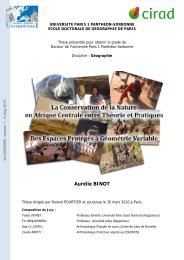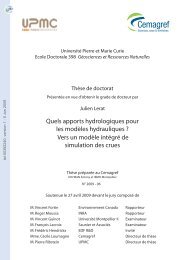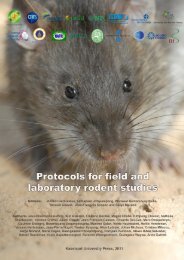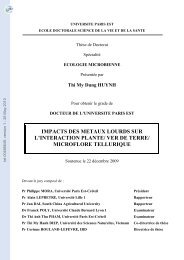Modeling and Inversion in Thermal Infrared Remote Sensing over ...
Modeling and Inversion in Thermal Infrared Remote Sensing over ...
Modeling and Inversion in Thermal Infrared Remote Sensing over ...
Create successful ePaper yourself
Turn your PDF publications into a flip-book with our unique Google optimized e-Paper software.
10 <strong>Model<strong>in</strong>g</strong> <strong>and</strong> <strong>Inversion</strong> <strong>in</strong> <strong>Thermal</strong> <strong>Infrared</strong> <strong>Remote</strong> Sens<strong>in</strong>g 24910.3.2 Spectral <strong>and</strong> Directional Capabilitiesird-00392669, version 1 - 9 Jun 2009The spectral dimension corresponds to the number <strong>and</strong> location of sensor waveb<strong>and</strong>swith<strong>in</strong> the TIR <strong>and</strong> optionally the MIR doma<strong>in</strong>s. The directional dimensioncorresponds to the number <strong>and</strong> angular distribution of view<strong>in</strong>g directions. Both dimensionsare used for rec<strong>over</strong><strong>in</strong>g emissivities <strong>and</strong> temperatures via model<strong>in</strong>g tools.The basic spectral configuration corresponds to TM <strong>and</strong> ETM, with 1 channel.Richer <strong>in</strong>formation is provided via two channels with GOES Imager, AVHRR <strong>and</strong>the ATSR suite; three channels with MODIS <strong>and</strong> GLI; <strong>and</strong> five channels with SE-VIRI <strong>and</strong> ASTER. Additional MIR <strong>in</strong>formation can be comb<strong>in</strong>ed with TIR <strong>in</strong>formation,to be used with cont<strong>in</strong>uous observations from geostationary sensors (SEVIRI,GOES Imager), or day night observations from sunsynchronous sensors (AVHRR,MODIS).The basic directional configuration corresponds to SEVIRI, GOES Imager, TM,ETM, <strong>and</strong> ASTER; with a s<strong>in</strong>gle view<strong>in</strong>g direction. Richer <strong>in</strong>formation is collectedfrom across track view<strong>in</strong>g with AVHRR, MODIS, GLI; <strong>and</strong> along track view<strong>in</strong>gwith the ATSR suite. Across track view<strong>in</strong>g allows a daily monitor<strong>in</strong>g, while sampl<strong>in</strong>gthe angular dynamic with<strong>in</strong> a given temporal w<strong>in</strong>dow (16 days for MODIS).This is of <strong>in</strong>terest for stable surface properties such as emissivity. For surface temperaturewhich fluctuates, captur<strong>in</strong>g the angular dynamic requires almost simultaneousobservations. This is possible with ATSR along track bi-angular observationsonly, which is limited.Future spaceborne missions will pursue current ones for long-term records: theGOES suite [100], NPOESS/VIIRS follow<strong>in</strong>g AVHRR <strong>and</strong> MODIS [101]. MTIprovides orig<strong>in</strong>al <strong>in</strong>formation: 2 MIR/3 TIR b<strong>and</strong>s, 0 ◦ <strong>and</strong> 50 ◦ along track. Atthe airborne level, the spectral dimension has been <strong>in</strong>vestigated with multispectral(TIMS, DAIS, MAS & MASTER) <strong>and</strong> hyperspectral (SEBASS [102]) sensors, <strong>and</strong>the directional dimension has been assessed with video cameras (see [103] with theReSeDA program). At the ground level, the spectral dimension has been exploredwith hyperspectral sensors (FTIR BOMEM [104]), or with broadb<strong>and</strong> radiometers[105–107], <strong>and</strong> the directional dimension has been exam<strong>in</strong>ed with goniometric systems[58, 108, 109].In the context of monitor<strong>in</strong>g l<strong>and</strong> processes, the various types of <strong>in</strong>formationpresented here are valuable for rec<strong>over</strong><strong>in</strong>g l<strong>and</strong> surface emissivity <strong>and</strong> temperature.Us<strong>in</strong>g this <strong>in</strong>formation requires design<strong>in</strong>g model<strong>in</strong>g tools <strong>and</strong> <strong>in</strong>version methods,either under development for prospective studies or with operational capabilities.10.4 Develop<strong>in</strong>g <strong>Model<strong>in</strong>g</strong> Tools <strong>and</strong> <strong>Inversion</strong> Methods<strong>Model<strong>in</strong>g</strong> tools aim at forwardly simulat<strong>in</strong>g, with different complexities, measuredbrightness temperature from emissivities <strong>and</strong> temperatures of <strong>in</strong>terest. Table 10.2provides an <strong>over</strong>view of the model<strong>in</strong>g tools currently used. Based on TIR fundamentals(Section 10.4.1), simple radiative transfer equations directly l<strong>in</strong>k measurementsUncorrected Proof
















